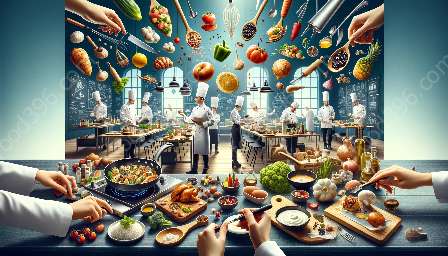Baking techniques are vital for anyone passionate about baking and pastry. Whether you're a culinary student or an at-home baker, mastering fundamental techniques sets the foundation for creating perfect bread, pastries, and desserts. In this comprehensive guide, we'll explore essential baking techniques that are integral to both the art of baking and pastry.
Understanding Ingredients
Before diving into the various baking techniques, it's crucial to understand the role of ingredients in baking. Flour, sugar, leavening agents, fats, and liquids all play a significant part in the chemistry of baking. By mastering the influence of these ingredients, you'll gain insight into how to manipulate recipes for different results.
Flour
Flour provides structure in baked goods. The type of flour used, such as all-purpose, bread, or cake flour, affects the texture and rise of your baked creations. Understanding the protein content and gluten development in different flours is essential for achieving the desired outcome.
Sugar
Sugar not only sweetens but also contributes to moisture retention and tenderness in baked goods. It caramelizes during baking, adding color and flavor to your creations. Different types of sugar, such as granulated, brown, or confectioners' sugar, serve unique purposes in baking.
Leavening Agents
Leavening agents, such as baking powder, baking soda, and yeast, are responsible for the rise and texture of baked goods. Understanding how to activate these agents and their reactions with other ingredients is crucial for achieving the desired volume and texture in your bakes.
Fats
Fats, like butter, oil, and shortening, contribute to the tenderness, flavor, and moisture of baked goods. The choice of fat affects the texture and richness of your creations. Learning how to properly incorporate and handle fats in recipes is fundamental to achieving the ideal results.
Liquids
Liquids, such as water, milk, and eggs, provide hydration and structure in baked goods. Understanding the role of liquids in recipes, including their temperature and quantity, is essential for achieving the desired consistency and texture in your bakes.
Mastering Mixing Techniques
Once you understand the role of ingredients, mastering mixing techniques is essential for creating the right texture and structure in your baked goods. The two primary mixing methods are the creaming method and the foaming method.
Creaming Method
The creaming method involves beating sugar and fat together to incorporate air into the mixture, resulting in a light and airy texture. This method is commonly used for making cakes, cookies, and buttercreams. Proper creaming leads to a well-aerated and uniform mixture, essential for achieving a tender and moist crumb.
Foaming Method
The foaming method involves beating eggs or egg whites to incorporate air and create volume in batters and mousses. This method is crucial for recipes such as sponge cake, meringues, and soufflés. Mastering the foaming method is essential for achieving the desired lightness and structure in your baked creations.
Kneading and Dough Development
For those venturing into bread and pastry making, mastering kneading techniques and understanding dough development is paramount. Proper kneading and dough handling contribute to the structure, rise, and texture of breads and pastries.
Kneading Techniques
Kneading is the process of working dough to develop gluten, which provides elasticity and structure. Different breads and pastries require specific kneading techniques, whether it's the fold and push method for artisan bread or the gentle folding technique for delicate pastries. Understanding how to knead and when to stop is crucial for achieving the desired crumb and texture.
Dough Development
Understanding the stages of dough development, from mixing to fermentation, allows you to manipulate flavors and textures in your breads and pastries. Whether it's a slow fermentation for complex flavors in sourdough or a quick rise for soft dinner rolls, mastering dough development techniques is essential for creating diverse and flavorful baked goods.
Controlling Baking Temperatures and Times
Lastly, understanding how to control baking temperatures and times is fundamental for achieving perfect results in the oven. Different types of baked goods require specific temperature and timing adjustments for the ideal rise, color, and texture.
Oven Temperature
Understanding your oven and its hot spots is crucial for consistent baking results. Whether it's adjusting the temperature for convection ovens or positioning racks for even heat distribution, mastering oven temperature allows you to bake with precision.
Baking Times
Following recommended baking times and understanding how to test for doneness is essential for achieving perfectly baked goods. Whether it's inserting a toothpick into a cake to check for moist crumbs or tapping the bottom of bread for a hollow sound, mastering baking times leads to consistently excellent results.
By understanding these essential baking techniques, you'll enhance your baking and pastry skills, whether you're pursuing culinary training or simply enjoying the art of baking at home. With practice and an understanding of the science behind these techniques, you'll be well-equipped to create delicious and impressive baked goods for any occasion.

